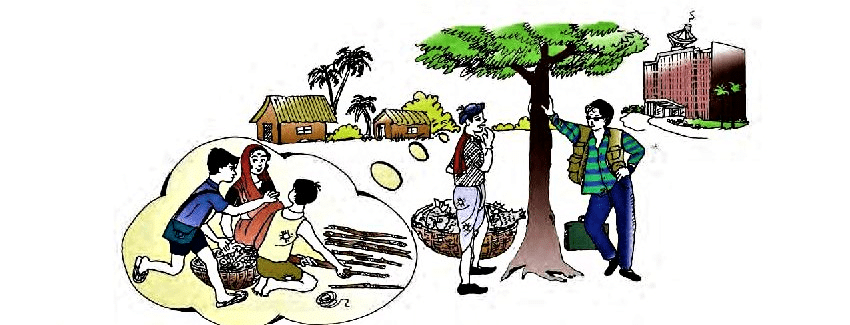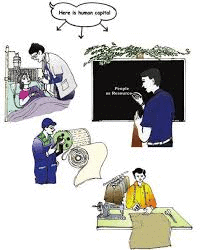Class 9 Economics Chapter 2 Extra Question Answers - People as Resource
Q1. For better economic growth, which investments in human resources should be done, either in modern technology, in healthcare and education, in food and drink or in transportation?
Only healthcare and education relate completely to human resources and so investment in this should be done for better economic growth.
Q2. Construction is an activity of which sector?
Construction is an activity of the Secondary sector.
Q3. Sprinkling crops with insecticide is an activity of which sector?
Since this is an activity that is a part of agriculture, it is an activity of the Primary sector.
Q4. Navodaya Vidyalayas have been started for which kind of school children?
Navodaya Vidyalayas have been started for talented school children residing in rural areas.
Q5. Sarva Shiksha Abhiyan is meant to provide what kind of education?
Sarva Shiksha Abhiyan is meant to provide elementary education (up to class VIII) to children in the age group of 6 to 14 years.
Q6. What is the age group of the population which is treated as the workforce?
The workforce population in India includes people from the age of 15 to 59 years. In other countries, this may be slightly different. For instance, it is 16 to 65 years in the USA.
Q7. Unemployment wastes what resources?
Unemployment refers to human beings and thus it washes human resources,
Q8. In which category of activity will you place a social worker educating poor children for free?
Since the social worker is not earning any money, his activity will be classified as a non-market activity.
Q9. Why do educated parents invest more in their children's education and health?
Educated parents invest more in their children's education and health because they realise that poor education and indifferent health is detrimental to their children's well-being and future.
Q10. Is it correct that disguised unemployment is very common in urban areas?
No, it is incorrect, as disguised unemployment is very common in rural areas, particularly in agriculture.
Q11. Why are rural women employed at very low wages?
In rural areas, girls are not given a proper education or given skill training for doing jobs due to being involved in household duties and the view that they should not go out of the home to work. Due to these factors, when they need a job, they are not able to demand as high wages as men can
Q12. When we refer to a woman as a 'resource', we are referring to which of her skills?
When a person is referred to as a resource, it refers to that person's productive skills and abilities.
Q13. Begging is which category of activity?
Begging does not involve the production of any goods or services and also does not add to national income. So, it is a non-economic activity.
Q14. In which area of India is the literacy rate the lowest?
The literacy rate in some areas of Madhya Pradesh is below 30 per cent, the lowest in India.
Q15. Which sector of the Indian economy absorbs the maximum labour?
Agriculture is the most labour absorbing sector of the economy.
Q16. Can finished goods produced by industry be treated as fixed capital?
Finished goods will be sold and replaced by other finished goods in the future and thus cannot be treated as fixed capital,
Q17. How will you define the life expectancy of a newborn baby?
Life expectancy is defined as the average length of life a newborn baby will live.
Q18. What is the major reason for education having an important role in human capital formation?
Education broadens the knowledge of people and provides them training, thus having an important role in human capital formation.
Q19. Is it true that the literacy rate of a population is the population multiplied by 100 divided by the number of literate people?
The literacy rate of a population is the number of literate people multiplied by 100 divided by the total population. So, the definition given in the question is incorrect.
Q20. Is drinking tea from a tea stall in the market a non-economic activity?
No, because when we drink tea from a tea stall, we pay for the tea and thus this is an economic activity.
Q21. Which person out of a farm labourer, a construction worker and a miner is having seasonal employment?
Miners and construction workers normally work in all seasons. Only a farm labourer will work for some part of the year and thus is having seasonal employment.
Q22. What is the meaning of vocational education?
'Vocational education' means 'training for a specific vocation' i.e. training for being employed in a particular job. It is education catering to the requirements of the economy.
Q23. What do you understand by the term 'human resource'?
Human resource is the term used for people who constitute work force for an organisation or country by their existing productive skills and abilities.
Q24. What is human capital?
When investment is made in form of education and medical care, the quality of population improves and it became a great asset it is called human capital.
Q25. A person is making envelops with the help of papers. In which sector should his activity be included?
If a person makes envelops with the help of paper his activities will be included in the Secondary sector.
Q26. Which state in India has the highest literacy rate?
Kerala has the highest literacy rate in India.
Q27. What do you understand by the term "Sarva Shiksha Abhiyan"?
Sarva Shiksha Abhiyan is a flagship programme of the Government of India that aims to provide elementary education to all children in the age group of 6 to 14 years.
Q28. What is the name of the school set in each district by the government for talented students of the rural area?
Navodaya Vidyalaya.
Q29. Which is the most labour absorbing sector of the economy?
Primary sector is the most labour absorbing sector of the economy.
Q30. Name the two types of unemployment that exist in rural India.
Two types of unemployment exist in rural India are "seasonal" and disguised unemployment.
Q31. Name the phenomenon of shifting of labourers from rural area to urban area in search of work.
Shifting of labourers from rural area to urban area in search of work is known as 'migration'.
Q32. What is the full form of GNP?
The full form of GNP is Gross National Product.
Q33. What is the current literacy rate of India according to the Census of 2011?
According to the Census of 2011, the literacy rate of India is 74 per cent.
Q34. Why is human capital the most important factor of production? Give three reasons.
Human capital is the most important factor of production for the following reasons
(i) Human capital refers to the people who possess the knowledge and enterprise to put together the other factors of production.
(ii) Investment in human capital yields a return just like an investment in physical capital.
(iii) It is essential, as physical capital cannot produce goods and services on its own
Q35. What are various activities which are classified into the three main sectors? Name each sector with suitable examples.
The three sectors of economic activities are
(a)Primary Sector which harvests or extracts natural products from the Earth; it involves the production of raw materials and food products. Examples include agriculture, dairy farming, mining and quarrying.
(b) Secondary Sector which involves the manufacture of finished goods. Examples include manufacturing and construction.
(c) Tertiary Sector include activities which support the Primary and Secondary sectors with services. Examples are transportation, banking, trade, insurance, legal services, administration and government.
Q36. What is the difference between economic activities and non-economic activities?
Economic Activities Activities which result in the production of goods and services which add to the national income are called economic activities. The activities classified in the three sectors are economic activities. Non-Economic Activities Those activities which are not performed for pay or profit, e.g., parents looking after their children or a mother cooking food for her family is a non-economic activity, as it is neither performed for pay or profit and nor does it add to the national income.
Q37. What role does education play in the growth of society?
Investment in educating children is similar to investment in land and capital, as it results in higher earnings for them and a greater contribution to society. Educated people make better use of resources like land and capital, leading to the development of society. Even in employment, better-educated people perform better in their jobs, leading to more efficient working of the organisation where they work.
Q38. Why does unemployment have a detrimental effect on the overall growth of an economy?
Unemployment tends to increases economic overload, i.e., the dependence of the unemployed persons on the people who are working goes up. This adversely affects the quality of life of people, as they have to live at subsistence level, which leads to poor health and even an increase in school dropouts. Ultimately this has a detrimental effect on the growth of the economy if it continues, as it wastes resources who can be gainfully employed.
Q39. Explain why Infant Mortality Rate (IMR) and literacy rate are considered
to be indicators of human resource development.
Infant Mortality Rate is a factor that can be associated with the well-being of a population. High infant mortality rates could reflect improper childcare owing to poverty, lack of education and other factors. Similarly, the literacy rate reflects the quality of a population. An illiterate and unhealthy population shows poor human development, whereas a literate and healthy population shows proper human development. Thus, infant mortality rate and literacy rate are considered to be indicators of human resource development.
Q40. Do you notice any difference between the two friends Vilas and Sakal? What are those?
The differences between the two friends Sakal and Vilas were:-
(i) Vilas's father died when Vilas was two years old whereas Sakal was living with his parents.
(ii) Sakal went to school, but Vilas did not go to school.
(iii) Sakal was interested in studies whereas Vilas was not interested in studies.
(iv) Sakal did a - course in computers and became employed whereas Vilas remained illiterate and was not employed.
(v) The condition of Sakal and his family became better whereas Vilas and his family lived in poverty.
|
55 videos|525 docs|78 tests
|
FAQs on Class 9 Economics Chapter 2 Extra Question Answers - People as Resource
| 1. What is meant by 'people as resource' in the context of economics? |  |
| 2. How can education enhance the concept of 'people as resource'? |  |
| 3. What are the benefits of viewing individuals as resources in a country’s development? |  |
| 4. How does population growth affect the concept of 'people as resource'? |  |
| 5. What role does skill development play in maximizing the potential of people as a resource? |  |
























